Check out our range of stock.
Didn't find what you like?
Send us a message
Found something out of stock?
Send us a message
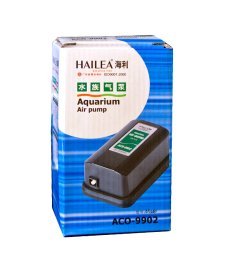
Description: Single Outlet 2.5 L/min Manufacturer: Hailea Features Small compact single outlet air pump for aquariums Modern compact design. Simple setup and operation, quick start. All models come with rubber feet, to avoid vibration. Reliable. Power usage: 2.2 watts Pressure: >0.01Mpa Size: 129x70x58mm Please remember to always use a check valve or non return valve.
$16.00
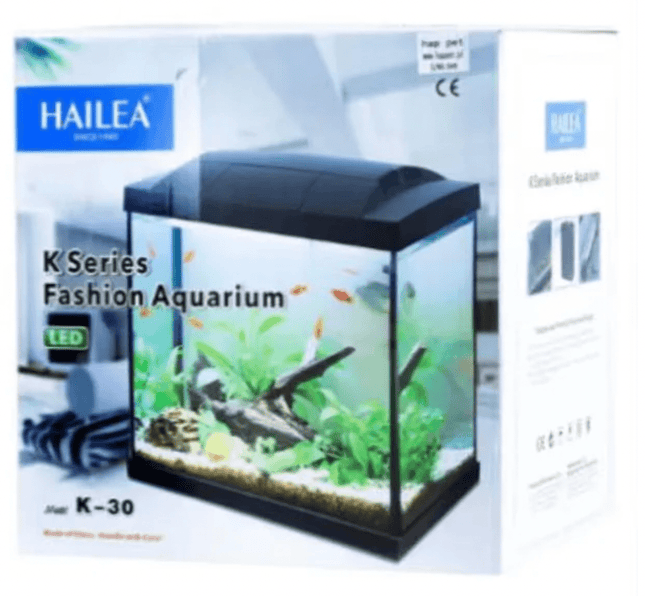
The HAILEA range includes aquariums suitable for beginners and for more experienced fish keepers. K-30 Package contents: Glass aquarium - LED illumination - 3 W Suspension filter HE-200 Internal Hang on filter 3w-200l/hr Dimensions: 36 x 24 x 31cm with folding lid Volume: 30 l Weight: 7 kg Black colour Pickup price quoted. If you require shipping please enquire
$169.00 $149.00

The HAILEA range includes aquariums suitable for beginners and for more experienced fish keepers. K-60 Package contents: Glass aquarium - LED illumination -5 W Suspension filter HE400 7W 380L/Hr Hinged Lid Dimensions: 59 x 31 x 45.6 cm (W x D x H) Volume: 60l Weight: 12kg Black colour
$260.00

Rasboras maculatus (the Spotted Rasbora) is a fish native to Southeast Asia. It is a peaceful schooling fish that is often kept in aquariums. It has a distinctive black spot on its caudal fin, and its body is a metallic silver color. It can reach up to 1.5 inches in length, and it is an omnivore. This fish is relatively easy to care for and can live up to 5 years in captivity. It is a popular and active fish that can add color and activity to an aquarium.
$6.50
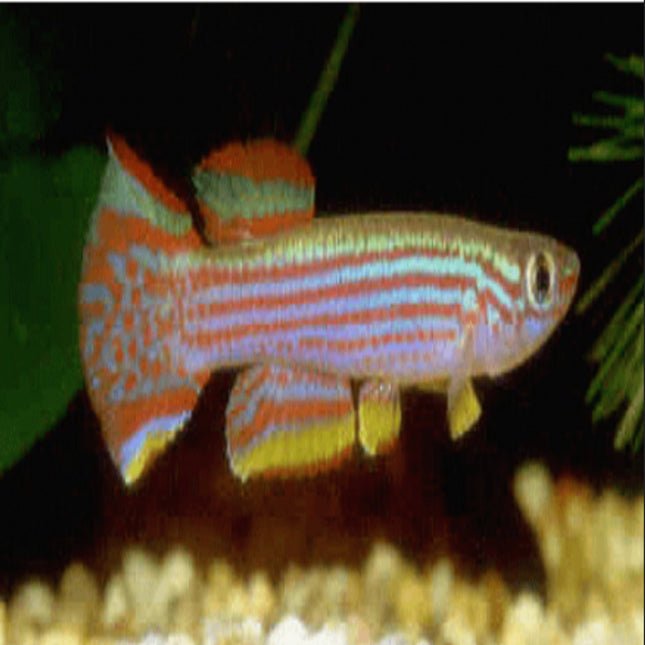
Distribution:Widely available from Equatorial Guinea (found in the lower Mitemele River drainage system), to northwestern Gabon (in the Mbei, Komo, Gabon, Abanga & lower Ogowe Rivers). An easy species to breed. Eggs are laid in top & bottom mops. Water incubation 13-15 days. Growth rate is quite rapid with sexual maturity being attained at about 4-5 months. Anthony Pinto in BKA Newsletter No.269 (January 1988) reported breeding them in water of 5 – 10 DH, pH 7, water temperature 24 – 26°C.Fry were fed newly hatched brine shrimp & microworm as a first food. Males were seen to start colouring up at 3 months.
$40.00
![[ARRIVED 3 - MAY - 2025] Apistogramma Cacatuoides Triple Red 4 - 6cm - Nano Tanks Australia](http://nanotanksaustralia.com.au/cdn/shop/files/arrived-3-may-2025-apistogramma-cacatuoides-triple-red-4-6cm-120252.jpg?v=1746298974&width=645)
This striking dwarf cichlid is an incredible color morph of the Cockatoo Dwarf Cichlid (Apistogramma cacatuoides) and is certain to be the centerpiece of any aquarium! The Triple Red Cockatoo Dwarf Cichlid (Apistogramma cacatuoides) is one of the most beautifully colored and most popular dwarf cichlids in the freshwater aquarium hobby. Males are particularly colorful, boasting incredible bright red coloration on the ample dorsal fin as well as the tail and anal fin. The body is typically a blue-violet sheen with a black horizontal stripe, which make for a very distinctive and beautiful appearance. As with most dwarf cichlids, females are less colorful, but still have an attractive appearance and plenty of personality. The Triple Red Cockatoo Dwarf Cichlid will thrive in an aquarium with a sandy substrate and plenty of refuge such as clay pots, driftwood, and rock formations. It is an excellent candidate for the planted aquarium, but it also needs a fair amount of open space. This cichlid is generally compatible with other peaceful fish as long as it has plenty of space. Territoriality is typically at its peak during spawning. Dwarf shrimp and other small, delicate invertebrates should not be kept with the Triple Red Cockatoo Dwarf Cichlid, but more durable, larger shrimp and snails could possibly make good tankmates in a large enough aquarium. If spawning is desired, tankmates of other species should be kept to a minimum or avoided altogether. Feeding is simple for the unfussy Triple Red Cockatoo Dwarf Cichlid. High-quality dry, frozen, and live meaty foods will all be readily accepted. Quality and variety are the keys to a diet that will ensure that this fish maintains optimal health and coloration. We are currently offering sexed, sub-adult specimens of this magnificent species. They are displaying very good coloration, but their color will be even more vibrant as they mature further! What We Like About This Fish: Beautiful iridescent blue-violet body coloration with very bright red coloration on the dorsal, anal, and caudal fins Hardy with plenty of personality Possible to breed in the aquarium Compatible with many other species in a spacious tank RECOMMENDED TANK PARAMETERS: Temperature: 72° - 84° F (22° - 29° C) pH: 6.0 - 7.0, tank-raised specimens are more flexible regarding pH level KH: 2 – 15 KH Minimum tank size: 20 gallons for a pair, but a larger tank is required for a group CARE GUIDELINES: Diet: Carnivorous. A variety of high-quality dry, frozen, and live meaty foods is necessary for optimal health and coloration. Social behavior: Congregates loosely in groups. Males can be territorial when attempting to spawn and females are very protective of their eggs during spawning. Origin: Tank-bred, but indigenous to Peru and Brazil Average adult size: 3 inches (7.5 cm) for males, 2 inches (5 cm) for females Average purchase size: 1 – 1.5 inches (2.5 – 3.8 cm)
$30.00 - $50.00
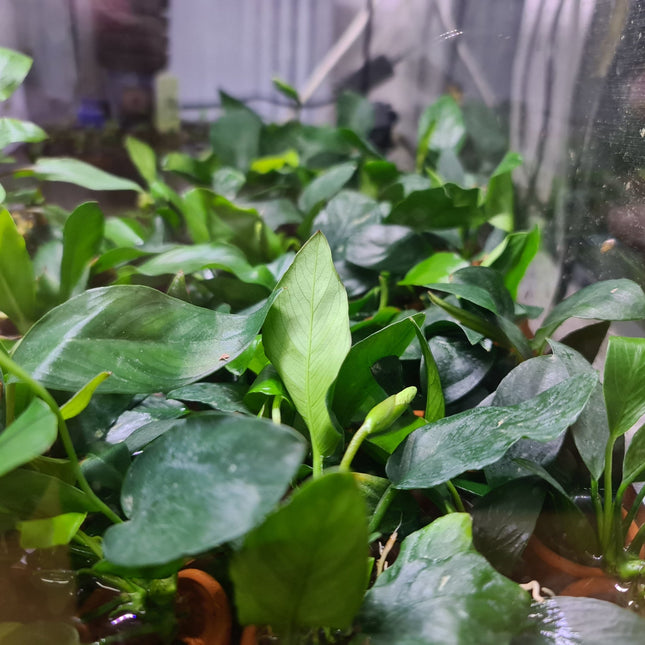
Sold as individual pieces. The image is an example of the quality you are getting Most of what is being sold are: Anubias Barteri Anubias Hastifolia Anubias Nana This is random and there is no choice on which plant you will get unless you are in the shop picking it out yourself
$20.00
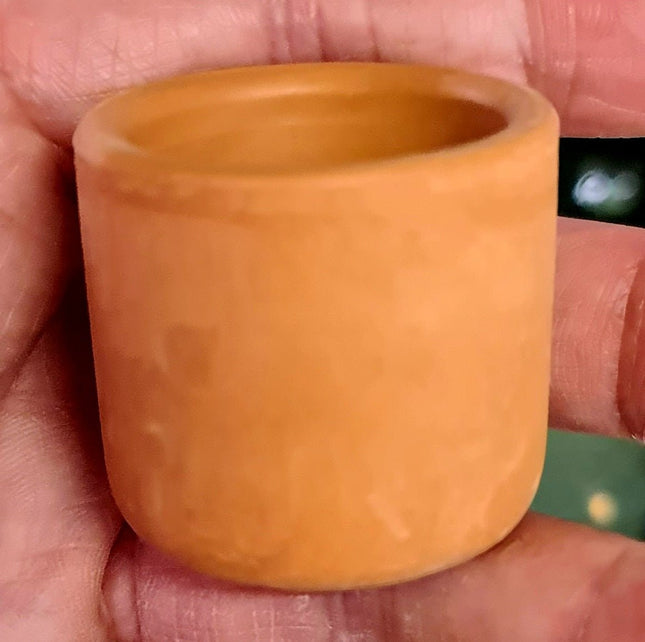
This terracotta pot is 3 cm tall and has a classic, round shape. It is made of terracotta, a type of earthenware clay, and has a light orange hue. The pot is perfect for small plants or succulents, and can easily be used as a decorative piece in any home or garden. The pot is unglazed, making it ideal for plants that require more water, as the clay is porous and allows for better drainage. The terracotta pot is sure to add a rustic charm to any space.
$2.20 - $2.50
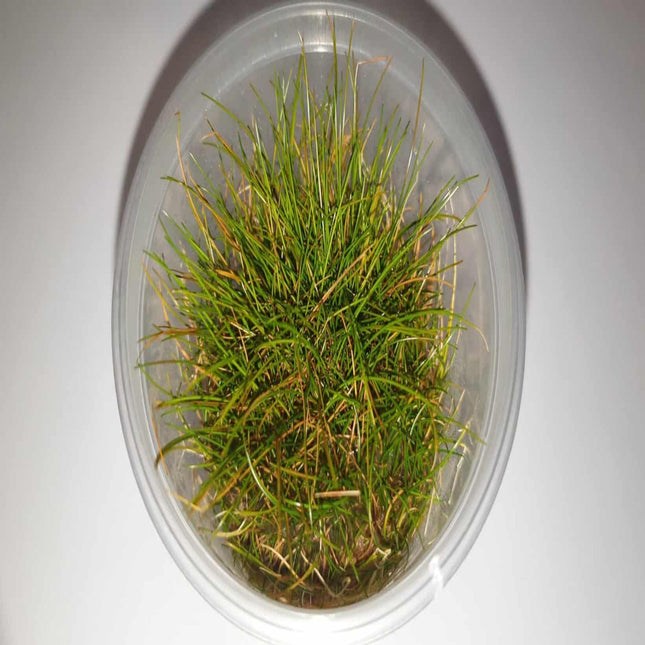
Eleocharis Belem known also as Japanese Dwarf Hair Grass, produces some of the smallest leaves from the Cyperaceae family. It is commonly used as a foreground plant needing minimal trimming. It uses runners to propagate. With a fertilized substrate and sufficient lighting, a dense carpet will be formed in a matter of weeks. Perfect plant for nano and small tanks. CO2 supplementation of 5mg/L and above for optimal growth.Family: CyperaceaeOrigin: CultivatedpH: 5.5 – 8Temperature: 10 – 30° CHeight: 2 cm – 10 cmLighting: Medium to Very High
$18.00

Windelov Java fern, also known as Microsorum pteropus 'Windelov', is a popular aquatic plant among aquarists due to its ease of care and unique appearance. Its leaves are characterized by small, narrow lobes that create a delicate, lacy effect. Windelov Java fern can be attached to rocks, driftwood, or other aquarium decor, making it a versatile option for aquascaping. It is also known to be hardy and tolerant of a range of water conditions. In addition to its use in aquariums, Windelov Java fern can also be used in terrariums to add a touch of greenery. PLEASE NOTE THAT THIS COMES IN A CLAY POT NOT A PLASTIC POT AS PER THE PICTURE
$19.00
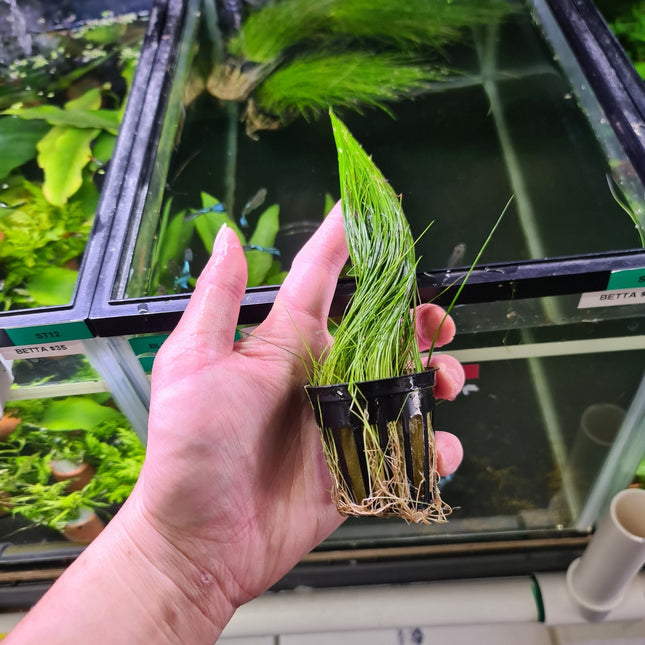
This Hairgrass on Pot brings a unique, vibrant look to any home decor! Its lush green foliage provides a natural beauty to any setting. The pot allows for easy transfer of the plant to any desired location. With proper care, this Hairgrass will last for years of enjoyment.
$10.00
![[ARRIVED 30 - JUL - 2025] 3BT12 - Yellow Hellboy Halfmoon Plakat Male Betta - Nano Tanks Australia](http://nanotanksaustralia.com.au/cdn/shop/files/arrived-30-jul-2025-3bt12-yellow-hellboy-halfmoon-plakat-male-betta-4868296.jpg?v=1753874611&width=645)
Discover this rare betta fish for sale in Australia, exactly as shown in the photos. Each fish is healthy, vibrant, and full of personality—making it the perfect addition to your aquarium. Shipped safely from Sydney, our bettas are ready to thrive in your home tank. Specifications: Males: Approx. 4–5 cm | Giant bettas: 7–9 cm Females: Approx. 3–4 cm | Giant bettas: 7–9 cm Age: 3–6 months Origin: Imported from Indonesia or Thailand Important Notes: Koi, grizzle, and fancy bettas may naturally change colour and pattern as they grow or during transit. Long-fin varieties may occasionally nip their own tails—this is a natural behaviour. All fish are kept in Sydney tap water (23–26°C, pH ~7) to ensure they’re well-adjusted and healthy. Shipping: We ship live bettas from Sydney every Monday and Tuesday for the safest transit. Please see our Shipping Policy for more details. Optional Video:Want a closer look at your betta before purchase? Order a video of your exact fish through the link provided.
$59.00 $30.00
![[ARRIVED 30 - JUL - 2025] 3BT14 - Yellow Hellboy Halfmoon Plakat Male Betta - Nano Tanks Australia](http://nanotanksaustralia.com.au/cdn/shop/files/arrived-30-jul-2025-3bt14-yellow-hellboy-halfmoon-plakat-male-betta-4729829.jpg?v=1753874612&width=645)
Discover this rare betta fish for sale in Australia, exactly as shown in the photos. Each fish is healthy, vibrant, and full of personality—making it the perfect addition to your aquarium. Shipped safely from Sydney, our bettas are ready to thrive in your home tank. Specifications: Males: Approx. 4–5 cm | Giant bettas: 7–9 cm Females: Approx. 3–4 cm | Giant bettas: 7–9 cm Age: 3–6 months Origin: Imported from Indonesia or Thailand Important Notes: Koi, grizzle, and fancy bettas may naturally change colour and pattern as they grow or during transit. Long-fin varieties may occasionally nip their own tails—this is a natural behaviour. All fish are kept in Sydney tap water (23–26°C, pH ~7) to ensure they’re well-adjusted and healthy. Shipping: We ship live bettas from Sydney every Monday and Tuesday for the safest transit. Please see our Shipping Policy for more details. Optional Video:Want a closer look at your betta before purchase? Order a video of your exact fish through the link provided.
$59.00 $30.00
![[ARRIVED 30 - JUL - 2025] 3BT15 - Yellow Hellboy Halfmoon Plakat Male Betta - Nano Tanks Australia](http://nanotanksaustralia.com.au/cdn/shop/files/arrived-30-jul-2025-3bt15-yellow-hellboy-halfmoon-plakat-male-betta-2676686.jpg?v=1753874612&width=645)
Discover this rare betta fish for sale in Australia, exactly as shown in the photos. Each fish is healthy, vibrant, and full of personality—making it the perfect addition to your aquarium. Shipped safely from Sydney, our bettas are ready to thrive in your home tank. Specifications: Males: Approx. 4–5 cm | Giant bettas: 7–9 cm Females: Approx. 3–4 cm | Giant bettas: 7–9 cm Age: 3–6 months Origin: Imported from Indonesia or Thailand Important Notes: Koi, grizzle, and fancy bettas may naturally change colour and pattern as they grow or during transit. Long-fin varieties may occasionally nip their own tails—this is a natural behaviour. All fish are kept in Sydney tap water (23–26°C, pH ~7) to ensure they’re well-adjusted and healthy. Shipping: We ship live bettas from Sydney every Monday and Tuesday for the safest transit. Please see our Shipping Policy for more details. Optional Video:Want a closer look at your betta before purchase? Order a video of your exact fish through the link provided.
$59.00 $30.00
![[ARRIVED 30 - JUL - 2025] 3BT16 - Yellow Hellboy Halfmoon Plakat Male Betta - Nano Tanks Australia](http://nanotanksaustralia.com.au/cdn/shop/files/arrived-30-jul-2025-3bt16-yellow-hellboy-halfmoon-plakat-male-betta-2244421.jpg?v=1753874612&width=645)
Discover this rare betta fish for sale in Australia, exactly as shown in the photos. Each fish is healthy, vibrant, and full of personality—making it the perfect addition to your aquarium. Shipped safely from Sydney, our bettas are ready to thrive in your home tank. Specifications: Males: Approx. 4–5 cm | Giant bettas: 7–9 cm Females: Approx. 3–4 cm | Giant bettas: 7–9 cm Age: 3–6 months Origin: Imported from Indonesia or Thailand Important Notes: Koi, grizzle, and fancy bettas may naturally change colour and pattern as they grow or during transit. Long-fin varieties may occasionally nip their own tails—this is a natural behaviour. All fish are kept in Sydney tap water (23–26°C, pH ~7) to ensure they’re well-adjusted and healthy. Shipping: We ship live bettas from Sydney every Monday and Tuesday for the safest transit. Please see our Shipping Policy for more details. Optional Video:Want a closer look at your betta before purchase? Order a video of your exact fish through the link provided.
$59.00 $30.00
![[ARRIVED 30 - JUL - 2025] 3BT22 - Yellow Hellboy Halfmoon Plakat Male Betta - Nano Tanks Australia](http://nanotanksaustralia.com.au/cdn/shop/files/arrived-30-jul-2025-3bt22-yellow-hellboy-halfmoon-plakat-male-betta-7887097.jpg?v=1753874679&width=645)
Discover this rare betta fish for sale in Australia, exactly as shown in the photos. Each fish is healthy, vibrant, and full of personality—making it the perfect addition to your aquarium. Shipped safely from Sydney, our bettas are ready to thrive in your home tank. Specifications: Males: Approx. 4–5 cm | Giant bettas: 7–9 cm Females: Approx. 3–4 cm | Giant bettas: 7–9 cm Age: 3–6 months Origin: Imported from Indonesia or Thailand Important Notes: Koi, grizzle, and fancy bettas may naturally change colour and pattern as they grow or during transit. Long-fin varieties may occasionally nip their own tails—this is a natural behaviour. All fish are kept in Sydney tap water (23–26°C, pH ~7) to ensure they’re well-adjusted and healthy. Shipping: We ship live bettas from Sydney every Monday and Tuesday for the safest transit. Please see our Shipping Policy for more details. Optional Video:Want a closer look at your betta before purchase? Order a video of your exact fish through the link provided.
$59.00 $30.00
![[ARRIVED 30 - JUL - 2025] 3BT23 - Yellow Hellboy Halfmoon Plakat Male Betta - Nano Tanks Australia](http://nanotanksaustralia.com.au/cdn/shop/files/arrived-30-jul-2025-3bt23-yellow-hellboy-halfmoon-plakat-male-betta-6361786.jpg?v=1753874678&width=645)
Discover this rare betta fish for sale in Australia, exactly as shown in the photos. Each fish is healthy, vibrant, and full of personality—making it the perfect addition to your aquarium. Shipped safely from Sydney, our bettas are ready to thrive in your home tank. Specifications: Males: Approx. 4–5 cm | Giant bettas: 7–9 cm Females: Approx. 3–4 cm | Giant bettas: 7–9 cm Age: 3–6 months Origin: Imported from Indonesia or Thailand Important Notes: Koi, grizzle, and fancy bettas may naturally change colour and pattern as they grow or during transit. Long-fin varieties may occasionally nip their own tails—this is a natural behaviour. All fish are kept in Sydney tap water (23–26°C, pH ~7) to ensure they’re well-adjusted and healthy. Shipping: We ship live bettas from Sydney every Monday and Tuesday for the safest transit. Please see our Shipping Policy for more details. Optional Video:Want a closer look at your betta before purchase? Order a video of your exact fish through the link provided.
$59.00 $30.00
![5BT36 - [ARRIVED 2 - JUL - 2025] Blue Halfmoon Betta Male - Nano Tanks Australia](http://nanotanksaustralia.com.au/cdn/shop/files/5bt36-arrived-2-jul-2025-blue-halfmoon-betta-male-9776105.jpg?v=1751530418&width=645)
Discover this rare betta fish for sale in Australia, exactly as shown in the photos. Each fish is healthy, vibrant, and full of personality—making it the perfect addition to your aquarium. Shipped safely from Sydney, our bettas are ready to thrive in your home tank. Specifications: Males: Approx. 4–5 cm | Giant bettas: 7–9 cm Females: Approx. 3–4 cm | Giant bettas: 7–9 cm Age: 3–6 months Origin: Imported from Indonesia or Thailand Important Notes: Koi, grizzle, and fancy bettas may naturally change colour and pattern as they grow or during transit. Long-fin varieties may occasionally nip their own tails—this is a natural behaviour. All fish are kept in Sydney tap water (23–26°C, pH ~7) to ensure they’re well-adjusted and healthy. Shipping: We ship live bettas from Sydney every Monday and Tuesday for the safest transit. Please see our Shipping Policy for more details. Optional Video:Want a closer look at your betta before purchase? Order a video of your exact fish through the link provided.
$38.00
![5BT46 - [ARRIVED 2 - JUL - 2025] Yellow Fancy Halfmoon Betta Male - Nano Tanks Australia](http://nanotanksaustralia.com.au/cdn/shop/files/5bt46-arrived-2-jul-2025-yellow-fancy-halfmoon-betta-male-9027320.jpg?v=1751530417&width=645)
Discover this rare betta fish for sale in Australia, exactly as shown in the photos. Each fish is healthy, vibrant, and full of personality—making it the perfect addition to your aquarium. Shipped safely from Sydney, our bettas are ready to thrive in your home tank. Specifications: Males: Approx. 4–5 cm | Giant bettas: 7–9 cm Females: Approx. 3–4 cm | Giant bettas: 7–9 cm Age: 3–6 months Origin: Imported from Indonesia or Thailand Important Notes: Koi, grizzle, and fancy bettas may naturally change colour and pattern as they grow or during transit. Long-fin varieties may occasionally nip their own tails—this is a natural behaviour. All fish are kept in Sydney tap water (23–26°C, pH ~7) to ensure they’re well-adjusted and healthy. Shipping: We ship live bettas from Sydney every Monday and Tuesday for the safest transit. Please see our Shipping Policy for more details. Optional Video:Want a closer look at your betta before purchase? Order a video of your exact fish through the link provided.
$38.00
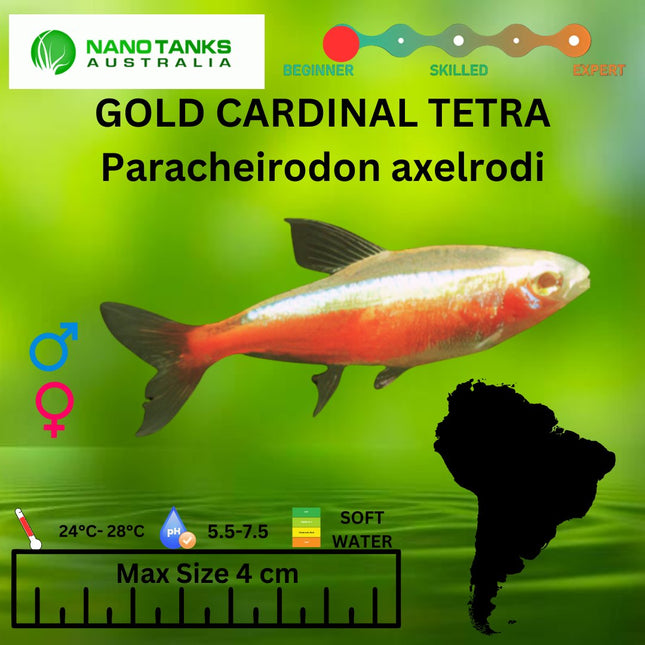
THIS IS THE GOLD FORM! The Cardinal Tetra is a popular freshwater fish that many people enjoy keeping in their home aquariums. Cardinal tetras will quickly become one of the favourite fish in your aquarium. These tiny, schooling fish are hardy and playful—so much so that they can outsmart even seasoned aquarists! Cardinal tetra is a friendly fish that shares space generously with its tank mate. While they can be hard to breed in captivity, these brightly coloured fish stay active and are available in multiples colours of red, yellow, and orange. Habitat The cardinal tetra is most commonly seen in slow-moving, shallow water. They mainly eat small animals on plants roots and leaf litter but have been known to take live prey as well. The Cardinal Tetra (Paracheirodon axelrodi) is a fish that has been around for centuries. Originating from the rivers in South America, specifically the upper Orinoco and to the Rio Negro River. These little guys are fascinating because they usually only live about 2-3 years due to their small size but have still managed to thrive since then. Colour A Cardinal tetra is not only beautiful, but it's an excellent fish for almost any aquarium. Consider these benefits; they're small and sturdy enough that they can live in a 20-litre tank. They are tolerant of water quality fluctuations and the temperatures found in your home or office environment. Plus, they grow up to just 5cm long, so their accommodations will be easy as pie! And while we know you'll want to buy this beauty some friends once he gets settled in his new digs, don't worry about other types of fish bothering him—he'd rather eat plants than other aquatic life forms! Potential Tank mates for Cardinal Tetras Cardinal tetras are one of the most popular fish species. They should always be kept in large schools and prefer to swim around with others, even if they're not their kind! If you want your tank to have the perfect balance between lively company and a serene environment for some time alone, then these guys will become part of it. Potential tank mates that may be suitable other than tetras are Danios, Rasbora, and Dwarf Gouramis. If the companion fish has a big mouth enough to swallow the cardinal tetra, it is not a suitable tank mate. Cardinal Tetra Care There are a lot of reasons to purchase a larger aquarium. One of the most important is that Cardinal Tetras live better in bigger tanks! These fish can be seen living happily and healthily in tanks with 20 litres, but we always recommend going as big as you possibly can if you wish to enjoy the fish schooling to full effect. Cardinal Tetras are delicate and need mature tanks with soft acidic water to thrive. They can't survive in a tank that's only been set up for an hour, so use caution if you're new! Luckily they love having stable conditions because it lets them live longer lives without getting sick as often. The best pH is below 6, while the hardness should stay below 4 dGH (decigrams per litre) since high levels of minerals make their health deteriorate quickly. Finally, this species loves warmer temperatures but does well from 23°C to 27 °C. We recommend having Floating Plants on their tanks; not only do they moderate the light, but floating aquatic plants also help with CO2 and oxygen levels in the water. Diet and Feeding Cardinal Tetra will eat most foods, but be sure to feed them 75% of high-quality flake food, so they stay healthy! Make sure to provide live foods or frozen snacks for your little guys, including brine shrimp and bloodworms that are high in protein. If you're going to feed them all day, try offering three minutes' worth of food every feeding--their little mouths can't handle large pieces very well. Gender Identification Males and females show few apparent differences between the sexes, with female cardinal tetras having a deeper body than males with an almost round belly. The hook protruding from the male's anal fin tells other prospective mates they are mature enough to breed! Breeding Cardinal Tetras Breeding cardinal tetras is a difficult task. But if you are persistent, success will be within your grasp! The female cardinal tetra produces eggs when she feels the need to reproduce - typically during evenings and late nights from 130-500 eggs. A separate breeding tank with stable water conditions, a pH of 5.0 to 6.0, and very soft water 3-5 dGH or below is essential for success. FREQUENTLY ASKED QUESTIONS What is the Difference between Neon Tetra and Cardinal Tetra? The most obvious difference between the Cardinal and Neon Tetras is their coloration. While both are beautiful in their own right, it's hard to ignore that for Neons, only half of its body sports a vibrant red stripe while Cardinals have an equally colourful anal fin and gills as well as whole-body stripes. The main differences between these two fish types come down primarily to colouring: one has less than dazzling colours on about 50% of his body (Neon), where the other will stun you with brilliant blues, greens, yellows--even oranges! Of course, some structural distinctions like fins, but we are all more interested in how they look when swimming around our tanks anyway. Can a tetra live without a filter and heater? A tetra can live without a filter yes, a heater not so much. Below 24 degree's C your tetra will not be happy campers, however a regular water change can suffice in lieu of a filter.
$6.00
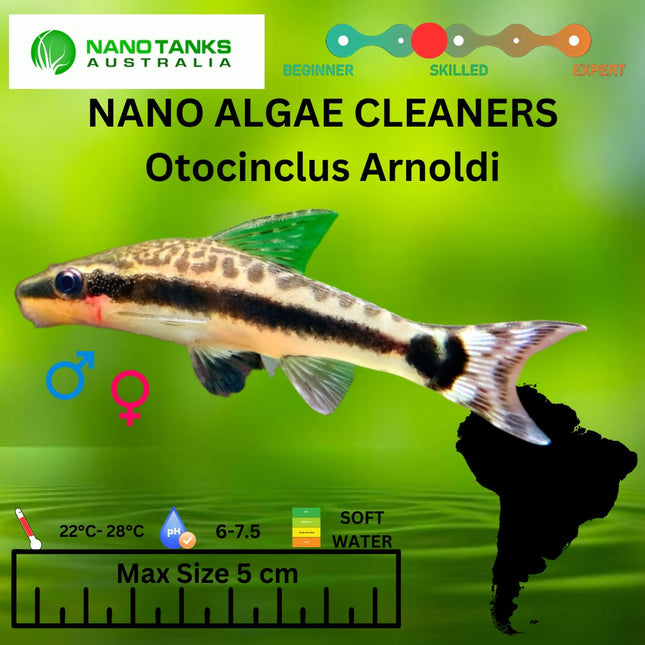
OVERVIEW Otocinclus Arnoldi, or as they are also called Otos, Otto Cats and Ottos. They may be the best scavengers for freshwater aquariums! These little guys eat algae but should not be confused with other similar looking fish that we sell such as Chinese Algae Eaters, Siamese Flying Foxes and Siamese Algae Eaters so make sure to check that before making a purchase. Otocinclus Arnoldi is the friendliest and most adorable little fish you could keep in your aquarium. They’re so easy to care for, provide hours of entertainment with their inquisitive nature, and they eat up all that pesky algae before it can grow out of control! HABITAT Otos are native to South America and can be found east of the Andes throughout the lowlands from northern Venezuela to northern Argentina. They spend most of their time in schools, swimming through moderate-to-slow rivers with well-oxygenated water. BUYING HEALTHY OTOS Otos are a great addition to any tank, but they’re very fragile. To make sure you don't lose them before the end of their first year, it's important that you pick out healthy Otos from your local fish store- if possible try and take some advice on what breeds will work best for your aquarium. BEHAVIOR If you keep your Otos properly, they'll show a ton of activity and personality during the day. They're industrious workers that will spend most of their time sucking on rocks, leaves with algae growing or anything else in sight! It doesn’t matter which species of Otocinclus you own, they all require the same water conditions – low stock density and pristine water – depending on your water source, you may want to use an RO system. AQUARIUM There are many reasons why you should consider getting an aquarium. For one, they can be a great avenue for relaxation and stress relief while making your home feel more inviting. Having fish also helps to improve the quality of air in our homes by producing negative ions that combat positive ones (i.e., it freshens up the room). To make sure your tank is healthy and happy, follow these guidelines: - You'll need an aquarium filter capable of cycling at least four times per hour (GPH) and with mature nitrate levels between 0-20ppm - No measurable ammonia or nitrite should be present either. - Otos prefer water with a stable pH that is slightly acidic (6-7.5). - The temperature inside their tanks should average about 72°F - 82°F degrees Fahrenheit (~22 °C ~ 28 °C) which allows them to thrive year-round without sustaining damage from changes in heat level outside. OTOCINCLUS Arnoldi SIZE The Otocinclus Arnoldi is a small fish that can grow to be about 1 ½ - 2 inches when fully mature. These quick and agile swimmers are able to dart from one end of the tank to another in an instant, making them ideal for smaller aquariums or tanks with slower-moving inhabitants. TANK MATES Otocinclus Arnoldi is known for being non-aggressive by nature. But because these tiny fish live in the wild, they have no means to protect themselves. If you choose tank mates wisely, then your Otos will be just fine! Otocinclus Arnoldi may not seem like much to look at with their small size and see-through skin but there is a reason why people keep them as pets; otos are peaceful little creatures that don't bother anybody or anything else in their home aquarium thanks to their lack of aggression which stems from living out on land without any natural predators where it has easy access food sources such as algae off rocks and plants around waterways. FEEDING Algae is the main food for Otos, but many aquariums can't produce enough to sustain them. If this happens in your tank, use algae wafers or Catfish pellets as a supplement. BREEDING Otos are hard to breed because you can't see a difference. But, female Otos tend to be larger and wider than males if you look closely enough for the little details. octocinclus
$24.00 $15.00

In stock now Black quartz sand fine grade Great for shrimp tanks or planted tanks. Inert and looks great. Come in and check it out or grab it online. Selling by the kg
$5.00
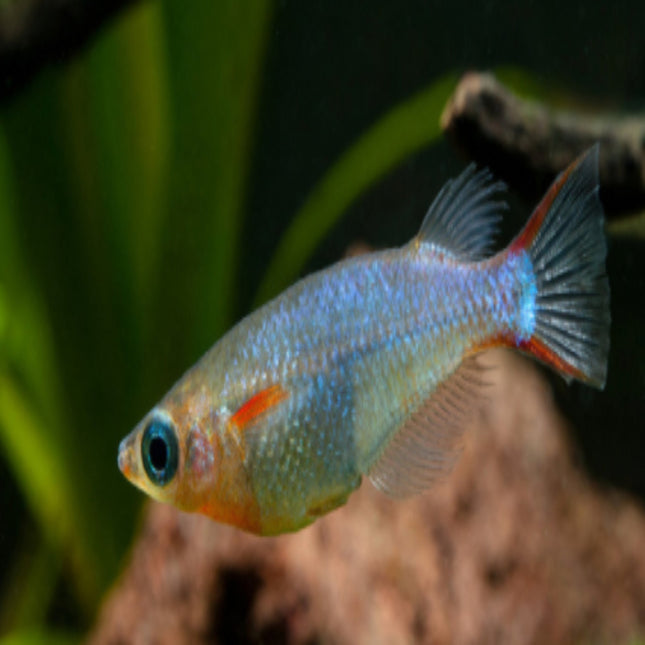
Neon Blue Ricefish (Daisy Ricefish) Oryzias woworaeOrigin Described and known only from a single locality, a stream named Mata air Fotuno, in Parigi district on the island of Muna, South East Sulawesi (Sulawesi Tenggara) province, Indonesia.Habitat Forested streams with sand and mud substrate and scattered leaf litter.Water Conditions Temperature: 23 – 27 °CPH: 6.0 – 7.5Hardness: 90 – 268 ppm
$15.00 - $60.00
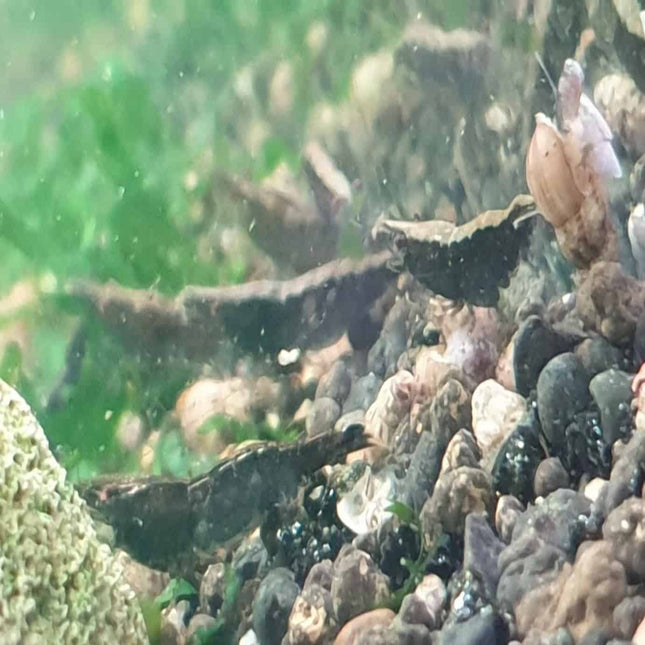
Incredible color-changing ability Relatively rare Completely peaceful disposition Safe with all plants Excellent scavenger RECOMMENDED TANK PARAMETERS: Temperature: 72° - 80° F (22° - 27° C) pH: 6.5 - 8.0 KH: 0 - 10 dKH Minimum tank size: 2 gallons
$7.50 $6.50
$30.00
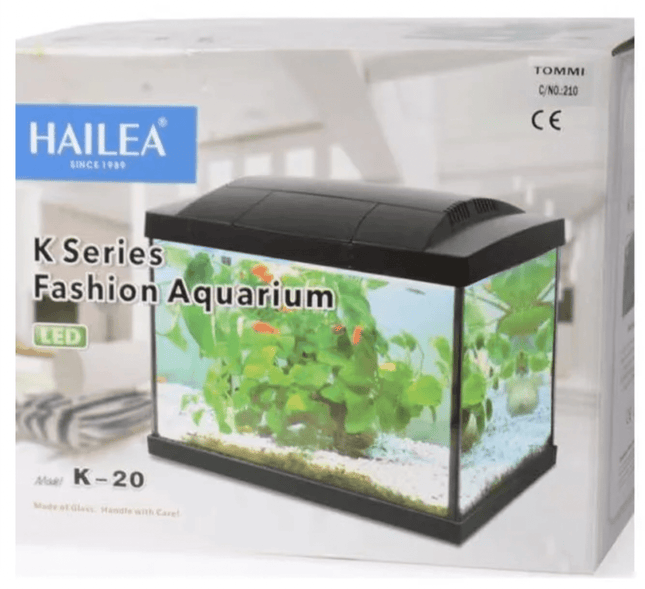
The HAILEA range includes aquariums suitable for beginners and for more experienced fish keepers. K-20 Package contents: Glass aquarium - LED illumination - 3 W Suspension filter including 3 cartridges (filtration: 200l / hr) Folding Lid Dimensions: 36 x 23 x 29 cm (W x H x D) Volume: 20 l Weight: 4 kg Black colour
$120.00
![[ARRIVED 4 - SEP - 2025] Aquael ASAP Filter 700 - Nano Tanks Australia](http://nanotanksaustralia.com.au/cdn/shop/files/arrived-4-sep-2025-aquael-asap-filter-700-4951895.jpg?v=1756999436&width=645)
The Aquael ASAP 700 is a powerful internal filter designed for larger aquariums, offering efficient water filtration and circulation. It is ideal for aquariums with a capacity of up to 250 liters (66 gallons). This filter is known for its high performance, energy efficiency, and ease of maintenance, making it suitable for maintaining clear and healthy water conditions in larger tanks. Aquael ASAP 700 Specifications: Recommended Aquarium Size: Up to 250 liters (66 gallons) Flow Rate: 650 liters per hour (171 gallons per hour) Power Consumption: 6 watts Dimensions: 78 x 94 x 228 mm Filtration Type: Mechanical Filtration: The sponge inside the filter captures debris, uneaten food, and waste, ensuring that water stays clear. Biological Filtration: The sponge also provides a surface for beneficial bacteria to grow, which is essential for breaking down ammonia and nitrites and maintaining stable water quality. Low Power Consumption: Despite its powerful flow rate, the ASAP 700 consumes only 6 watts of energy, making it an energy-efficient option for continuous use in larger tanks. Quiet Operation: The filter is designed to operate quietly, making it suitable for placement in any environment, including bedrooms or offices, without causing noise disruption. Compact and Slim Design: The ASAP 700 features a slim and compact design, allowing it to fit easily into most aquariums without taking up excessive space. This ensures that the filter integrates well into the tank without detracting from the visual appeal. Easy to Clean and Maintain: The modular design of the filter allows for easy removal of the sponge for cleaning. Simply detach the filter body from the motor and rinse the sponge during regular maintenance to keep the filtration system running efficiently. This ease of maintenance helps ensure the longevity and consistent performance of the filter. Improved Oxygenation: The filter not only circulates water effectively but also improves oxygenation, ensuring that fish and other aquatic life have access to the oxygen they need for healthy living. Key Features: High Flow Rate: With a flow rate of 650 liters per hour, the ASAP 700 provides powerful filtration for larger aquariums, ensuring efficient water movement and filtration. Effective Filtration: It delivers both mechanical and biological filtration, helping maintain a clean, stable, and healthy environment for fish and plants. Energy-Efficient: Operating at only 6 watts, the filter is energy-efficient, providing strong filtration without driving up energy costs. User-Friendly: The modular design allows for quick and easy maintenance, making it a convenient option for hobbyists who want to maintain optimal water quality without much effort. The Aquael ASAP 700 is ideal for aquarists looking for a reliable and powerful internal filter for larger aquariums. Its strong filtration capacity, low energy consumption, and ease of maintenance make it a top choice for maintaining a healthy aquatic environment in tanks up to 250 liters.
$65.00
![[ARRIVED 4-SEP-2025] AQUAEL SAS Filter 500](http://nanotanksaustralia.com.au/cdn/shop/files/sas_website_header-scaled.jpg?v=1757031099&width=645)
The Aquael SAS-500 Surface Skimmer is a compact internal filter designed to clean the top layer of water in your aquarium. Removes Surface Scum: It effectively eliminates unsightly surface films made up of dust, protein films, and plant residue, improving both the aesthetics and the health of your aquarium. Adjustable Flow Rate: You can adjust the skimmer’s output to suit the needs of your aquarium, making it ideal for both small and large-sized aquariums. High Capacity and Energy Efficient: With a 4.4W pump, it’s suitable for aquariums up to 500L and has a maximum flow rate of 500 lph (liters per hour). Maintenance-Free Float: The float automatically adjusts to changing water levels, ensuring consistent operation without daily adjustments. Easy Installation: Comes with suction cups for secure attachment inside your aquarium and requires no complex setup. Safety for Inhabitants: A built-in sponge pre-filter prevents shrimps and small fish from accidentally entering the motor compartment. This skimmer is highly recommended for maintaining clear water surfaces, especially in open tanks or aquariums with a high bioload, where more waste tends to accumulate on the surface. It’s a simple yet effective solution for enhancing oxygen exchange and light penetration into your aquarium. The SAS-500 Surface Skimmer is European made in-house at the Aquael factory in Poland and comes with a 2-year warranty.
$69.00
![[ARRIVED 4 - SEP - 2025] AQUAEL Unifilter UV 500 750 1000 - Nano Tanks Australia](http://nanotanksaustralia.com.au/cdn/shop/files/arrived-4-sep-2025-aquael-unifilter-uv-500-750-1000-7487973.png?v=1757086336&width=645)
The Aquael Unifilter Range is designed for optimal filtration and aeration in both freshwater and saltwater aquariums. These internal filters are well-known for their reliability, ease of maintenance, and innovative design. Each model in the Unifilter range comes with a set of features aimed at keeping aquarium water clean, clear, and oxygenated, ensuring the health of aquatic life. Below is an in-depth look at the specifications for each model and a detailed description of their key features. Key Specifications for Aquael Unifilter Range: Aquael Unifilter 500 Recommended Aquarium Size: 100 to 200 liters Flow Rate: 500 liters per hour Power Consumption: 5.2 watts Dimensions: 5.5 x 4 x 16 cm Filtration Media: Sponge Max Depth: 50 cm Additional Features: Adjustable flow rate, two-stage filtration system, integrated aeration nozzle Aquael Unifilter 750 Recommended Aquarium Size: 150 to 250 liters Flow Rate: 750 liters per hour Power Consumption: 7.5 watts Dimensions: 6 x 4.5 x 19 cm Filtration Media: Sponge Max Depth: 60 cm Additional Features: Adjustable flow rate, two-stage filtration system, integrated aeration nozzle Aquael Unifilter 1000 Recommended Aquarium Size: 200 to 300 liters Flow Rate: 1000 liters per hour Power Consumption: 11 watts Dimensions: 6.5 x 5 x 22 cm Filtration Media: Sponge Max Depth: 70 cm Additional Features: Adjustable flow rate, two-stage filtration system, integrated aeration nozzle Key Features of the Aquael Unifilter Range: Dual-Stage Filtration System: The Aquael Unifilter range features a two-stage filtration system that combines mechanical and biological filtration. This ensures efficient removal of debris and waste while promoting the growth of beneficial bacteria, essential for maintaining the nitrogen cycle in aquariums. The sponge media inside the filter effectively captures particulate matter, while also providing a surface area for beneficial bacterial colonization. Aeration Functionality: All Aquael Unifilter models come with an integrated aeration nozzle that promotes oxygen exchange in the water. This feature ensures that the water remains well-aerated, which is crucial for the health of fish and plants, particularly in densely stocked aquariums. The air intake system can be adjusted to control the level of aeration according to the needs of the tank’s inhabitants. Adjustable Flow Rate: Each Unifilter model allows for easy adjustment of the flow rate, enabling users to customize the water circulation based on the size of their aquarium and the specific needs of their aquatic life. For example, delicate fish or plants may require a gentler flow, while larger or more active species might benefit from higher water movement. The flow control is conveniently located on the filter, making adjustments simple and hassle-free. Quiet Operation: Aquael Unifilter models are designed for quiet performance. The advanced motor technology ensures that the filters operate with minimal noise, making them ideal for aquariums located in living rooms, bedrooms, or offices. Despite their high efficiency, these filters work quietly, ensuring a peaceful environment for both aquarium inhabitants and their keepers. Compact and Easy to Install: These internal filters feature a compact design, allowing them to be discreetly placed within the aquarium without taking up too much space. They are easy to install, thanks to strong suction cups that securely attach the filter to the aquarium wall. The filters can be installed vertically or horizontally, offering flexibility in placement depending on the layout of the tank. Easy Maintenance: Aquael Unifilters are designed for easy maintenance. The filter media can be easily removed and rinsed, ensuring that the filtration system remains efficient without the need for frequent replacements. This quick-access design allows users to maintain the filter with minimal effort, which is particularly beneficial for busy aquarists. Directional Flow Control: Each model in the Aquael Unifilter range comes with a directional flow control nozzle that allows users to direct the flow of water as needed. This helps create specific current patterns within the aquarium, which can be beneficial for fish species that prefer certain water flow conditions or for distributing nutrients evenly across the tank. Durability and Safety: The Aquael Unifilter range is built to last, using high-quality, corrosion-resistant materials that ensure longevity, even in saltwater environments. The electrical components are fully sealed, ensuring that the filters operate safely underwater. Aquael filters meet stringent safety standards, making them a trusted choice for aquarium enthusiasts. Summary: The Aquael Unifilter Range offers reliable, energy-efficient filtration for freshwater and saltwater aquariums. Available in three models—500, 750, and 1000—these internal filters provide powerful two-stage filtration, adjustable water flow, and integrated aeration, ensuring a healthy aquatic environment. Their compact design, quiet operation, and ease of maintenance make them ideal for aquarists seeking a dependable filtration solution. Whether you have a smaller tank or a larger setup, the Aquael Unifilter ensures clean, well-oxygenated water with minimal effort.
$135.00 - $195.00

Short Description:Welcome the incredible Australian Yabby Crayfish to your aquarium! Renowned for its hardiness, vibrant blue morphs, and engaging behavior, the Common Yabby (Cherax destructor) is a perfect choice for both beginner aquarists and experienced aquaculture enthusiasts. Add a unique touch of life to your tank with this fascinating freshwater crustacean. Key Features & Highlights (Bullet Points) 🎨 STUNNING COLOR VARIATIONS: While often a classic slate blue or olive green, we selectively offer stunning electric blue and even ghostly white specimens. Each Yabby is uniquely beautiful. 💪 INCREDIBLY HARDY & ADAPTABLE: Known for their resilience, Yabbies tolerate a wide range of water conditions, making them an excellent choice for those new to keeping crayfish. 🐾 ACTIVE & ENTERTAINING: Watch them explore, scavenge, and burrow! Yabbies are full of personality and provide endless fascination as they interact with their environment. 🌱 PERFECT FOR AQUACULTURE: A fast-growing species, Yabbies are a popular choice for sustainable home harvesting or farm pond rearing (where permitted). 🔍 NATURAL ALGAE EATER: They help keep your tank clean by consuming leftover food, detritus, and soft algae, acting as a valuable part of your aquarium's cleanup crew. Detailed Description Bring a piece of Australian freshwater ecosystems into your home with the remarkable Yabby Crayfish. Cherax destructor, whose scientific name hints at its powerful claws, is one of the most common and beloved crayfish in the aquarium trade—and for good reason! These charismatic crustaceans are not just survivors; they are thrivers. Their curious nature and constant scavenging make them a captivating centerpiece in any suitable aquarium. You'll be mesmerized watching them methodically explore every rock, cave, and plant, using their delicate antennae to sense their world. Beyond their beauty, Yabbies are practical. They are prolific consumers of waste, helping to maintain a balanced and cleaner tank environment. Whether you're looking for a unique pet, a biological cleanup crew member, or a sustainable aquaculture project, the versatile Yabby is an outstanding choice. Ideal For: Species-only aquariums Large community tanks with fast, top-dwelling fish (use caution with bottom-dwellers) Educational classroom habitats Sustainable aquaculture and pond systems Aquarists seeking a low-maintenance but engaging invertebrate Care Guide & Specifications (At a Glance) Parameter Requirement Tank Size Minimum 20 gallons for one adult. Larger is always better. Water Temp 60°F - 75°F (16°C - 24°C) pH Level 7.0 - 8.0 (Neutral to Slightly Hard) Temperament Semi-Aggressive. Best kept alone or with species that won't be seen as food or competition. Diet Omnivore. Sinking pellets, blanched vegetables (zucchini, cucumber), algae wafers, and occasional protein (bloodworms, small pieces of fish). Lifespan Typically 3-5 years, but can live longer with excellent care. Adult Size 4 - 8 inches (10 - 20 cm) Important Notes & Considerations ⚠️ CANNABALISTIC TENDENCIES: Housing multiple Yabbies together, especially in a small tank, can lead to aggression and cannibalism. Provide ample space and hiding spots if attempting a group. 🦀 EXPERT ESCAPISTS: A secure, tight-fitting lid is NON-NEGOTIABLE. Yabbies are famous escape artists and will find any gap. 🌿 LIVE PLANTS: Be aware that Yabbies are natural diggers and foragers. They may uproot or eat tender live plants. Hardy plants like Java Fern or Anubias are safer choices. 🐠 TANKMATES: Choose carefully! They may try to catch slow-moving or bottom-dwelling fish (e.g., Corydoras, fancy Goldfish). Fast, upper-level fish (e.g., Danios, Tetras) are safer. Live Arrival Guarantee:We pride ourselves on careful packaging and shipping. Our live arrival guarantee ensures your Yabbies are delivered healthy and active. Please be prepared to acclimate them immediately upon arrival. Why Choose Us? ✅ Ethically Sourced: Our Yabbies are sourced from reputable breeders. ✅ Healthy & Vibrant: We ensure all livestock is quarantined and healthy before sale. ✅ Expert Support: Have questions? Our team of aquarium experts is here to help you succeed! Add this amazing invertebrate to your cart today and enjoy the unique experience of keeping a Yabby Crayfish!
$4.50
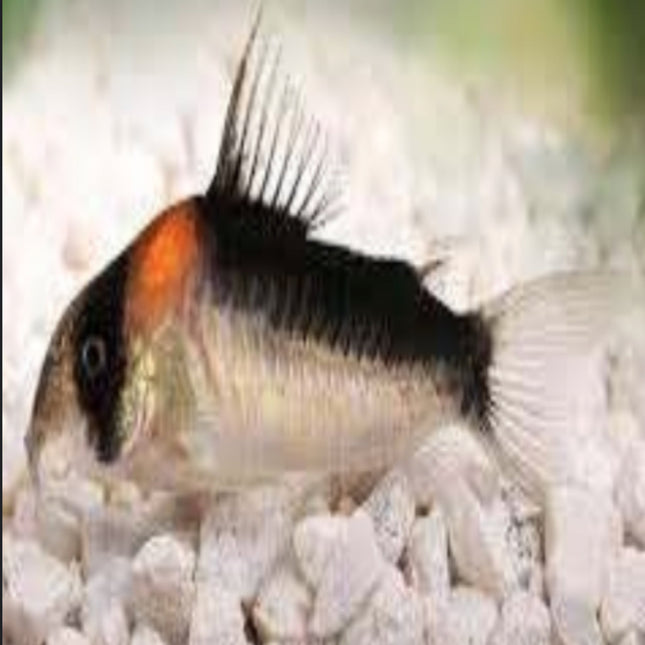
Corydoras Adolfoi: One of the Most Mysterious Fish in the Aquarium World OVERVIEW: These flashy and peaceful little freshwater fish are a rare find in the aquarium world. They have been making appearances for only as long as any one can remember, but no one is quite sure why they’re so elusive! The dolfo's cory cat fish (lat. Catfish Corydoras adolfoi) might be small-sized, brightly colored, and usually very calm when kept in an aquarium—but this recent newcomer to tanks has less popularity than other species of its own genus. Catfish are the perfect nocturnal creatures. They like to stay at the bottom of an aquarium and can only be seen in their natural habitat during nighttime hours because they're so small-featured! Some catfish, such as Glass Catfishes and Upside Down Catfish that reside on top surfaces of water tanks from time to time, have evolved a different strategy for survival than most other types of fish who live at or near the ground level. HABITAT: It seems that this Corydoras endemic is likely encountered only in the Rio Negro tributaries, São Gabriel da Cachoeira municipality, Brazil. However many sources state that these fish species are found living in slow-moving blackwater tributaries and flooded forest areas - where their water has a special tea color because it's been so rich with tanning substances for years now. SIZE AND LIFE SPAN OF CORYDORAS ADOLFOI 3CM: Corydoras Adolfoi is a unique fish that can live up to 5 years. Females are about five and half centimeters long, while the males are just slightly shorter in length at four and three quarters of a centimeter. These little guys have no teeth or scales but they do know how to defend themselves with their thick skin! Corydoras adolfoi measures an average size for females around five and one-half centimeters long whereas males measure approximately 4 3/4 cm on average making them relatively small in comparison; however these aquatic creatures prove fierce defenders thanks to their tough textured skin which has neither teeth nor scales. COLOR: Adolfo's Catfish has a beautiful coloring that resembles the one of corydoras panda, but it is unlike this fish because Adolfo’s catfish also holds an orange spot located between its dorsal and eyes. There is a black strip across its back with another going across both of his eyes. BEHAVIOR: Adolfo's catfish are not only active during the day but they also have a variety of behaviors. Catfish can spend most of their time on the tank bottom looking for food, swim to the water surface in order to take some air or be found deep within layers of medium-sized fish. TANK MATES: Catfish are group animals, so to make them feel most comfortable they need their species around. To create a complete fish school you will need at least 8 different types of catfish! If your tank is smaller than 500 gallons it may be difficult or even impossible for any one type of catfish to thrive on its own because the competition between other fish in the environment would drive that particular species away from an area and into extinction due to isolation. As you’ve understood, the best tank mates for your fish are its relative species. Keep in mind that various Corydoras can't be kept together and they should stay in one school so Adolfo's catfish won't fight with panda corys. If these fishes aren't aggressive towards Adolfo's catfish then it will be happy to share your home peacefully as well! FEEDING: With Corydoras, it's all about the bottom of the tank. These fish will eat most food that sinks to there. You'll want to supplement sinking algae pellets with flake foods, dried foods or other sinking goods like catfish pellets for a complete diet-scheme. Though these animals do have their carnivorous side, they also love Bloodworm and Brine Shrimp as treats! GENDER DIFFERENCES: corydoras adolfoi's females are admittedly larger than their male counterparts. The difference in size is especially pronounced when it comes to the reproductive fish species of this genus, with the female being much bigger and more dominant during mating rituals. BREEDING: Breeding is an interesting process that can be a little difficult. One of the most important aspects to breeding Corydoras fish for example, you should put one female and two males into separate tanks with high-quality food. When it's time to breed your new favorite pet in a tank full of water, start by putting just one female fish together with two male ones inside their own individual containers filled up completely from top to bottom every day while providing them feeders packed tight with protein rich foods such as beef heart or shrimp pieces twice per day ad libitum (ad liberally) until they become ravenously hungry within 8 hours after being fed each time because this tells you that they are ready for action! Adolfo's catfish may lay eggs right on the tank bottom, but it is recommended to add some lobed leaves or a synthetic shower pouf. Female fish can start laying their eggs quickly after puberty and mating; this process starts with them getting rounded up due to pregnancy. To make sure your female fish stays healthy during her journey of spawning, you should have water that remains cold at all times in addition to increasing its flow simultaneously because they're not able get enough oxygen otherwise as they are very sensitive when pregnant. Both the egg incubation time and hatching are dependent on ambient temperature with a typical range of 3-4 days. The larvae's ability to eat their yolk sacs enables them to start feeding themselves, which is when live food can be introduced into the diet such as brine shrimp or other similar foods. Most breeders add some methylene blue or any substances that help prevent fungal infection in order for eggs to hatch properly without being harmed during this process after about three four days at most depending on environmental temperatures. FAQ Is Corydoras adolfoi and Corydoras duplicareus the same? Corydoras adolfoi and Corydoras duplicareus are both a type of catfish with different adaptations, but they do have one noticeable difference: serrations on the posterior edge of their pectoral fin spine that can only be seen if you shine light from underneath it to see them up close. Corydoras adolfoi tends to be more slender than its counterpart while also having narrower black bands; however, like other genetically related fish species such as humans or sled dogs (or any dog breed for that matter) there is variation in how these two types look depending on where they live because water quality influences weight gain and slimness just like diet does!
$28.00
![[ARRIVED 5 - JUN - 2025] Gold Axolotl 12 - 15cm - Nano Tanks Australia](http://nanotanksaustralia.com.au/cdn/shop/files/arrived-5-jun-2025-gold-axolotl-12-15cm-670199.jpg?v=1749114211&width=645)
Axolotls: A Giant Salamander with a Superpower The Mexican walking fish The Axolotl is a fascinating creature rarely seen by people in the wild, descending from the tiger salamander Ambystoma tigrinum and indigenous to central Mexico for about 10,000 years. Axolotls are a newer species that evolved after the chaos and floods in North America after the younger dryas period, and so this creature gives us insights into an emergent species. Sadly, much of its suitable habitat has been drained due to human intervention. These two spring-fed lakes (lake Xochimilco and lake Chalco) along the southern edge of the Basin of Mexico has been reduced by 77% recently. Scientific research has discovered something amazing Did you know these Salamanders have superpowers? First, Axolotls are specially designed for camouflage. With dark-colored bodies and the ability to shift their hue a few shades lighter or darker as needed, they can easily blend in with leaves on trees! Pink and light-colored variations are bred only by humans to make for an interesting-looking pet. Axolotls are able to regenerate a new limb five times without even leaving scars – and do it in a matter of weeks. Also, the Axolotl can regenerate organs, jaws, and spines and can do this countless times while being entirely functional. Scientists want to understand the ability that Axolots inherently possess, so it is an extensively studied creature. To top it off, they say that this Axolotl has an innate superpower to resist cancer—1,000 times more than mammals. Indeed an amazing creature and a worthy critter for observation in the aquarium. Axolotl Size The Axolotl is a strange and fascinating creature that can grow up to 25cm. Axolotls are the fastest-growing frog-like creatures on earth! After reaching sexual maturity at 8 or so centimeters, most continue their growth until they reach about 20 cm long before stopping. Since Victorian times, they have been bred as pets but were only scientifically classified by scientists in 1859 when Mr. Charles Darwin gave them the funky name Axolotl Ambystoma Mexicanum because he found one near Mexico City while doing research. Diet In the wild, axolotls feed on snails, worms, crustaceans, and small fish. They can be fed a variety of brine shrimp or frozen food in captivity instead of wild food to avoid parasites that their natural prey could carry. In general, they do not need vitamins for healthy growth because they have a healthy appetite. However, it’s essential to ensure he has plenty of quality protein since his primary source would otherwise come from munching on other creatures. Adult axolotls appreciate a feed about once a week. One way to feed them is to place food with round-nosed forceps in the tank near where your animal lives, and you may also drop food into their water, as close to them as possible when they are active. If it seems like your Axolotl doesn’t eat much during daylight hours, try feeding it in the evening so uneaten food does not stay in the water. Axolotl Life Span There are few things as fascinating as axolotls. Strangely, Axolotls have been known to live past 20 years- but it is unusual (and almost unheard of) for one to make it over 10! Axolotl Housing A 60 litre reptile aquarium is the perfect size for one adult axolotl, but it can become messy due to constant waste. If you are looking for a 100+ litre tank instead, you will avoid this issue; in fact, I recommend doing so because as soon as you add in fish, it would be a messy affair. Ensure water parameters stay at an optimum level by filling the whole thing up and changing the water regularly, or else mold will start growing on anything inside! A filter will help maintain safe water parameters but beware of the conditions axolotls like. However, ensure that your tank has a spray bar or some other type of outlet to quickly and safely spread this water throughout. Axolotls do not tolerate strong flows so they need more delicate care than fish otherwise their health may suffer in ways from losing their appetite to developing stress-related diseases. Lighting and Temperature Axolotls do not require lighting, and new axolotls may be shy if kept in a brightly lighted tank. Lighting is for our viewing pleasure and the benefit of aquarium plants, not the Axolotls. This Salamander lives in habitats such as caves, amongst wood or vegetation. It would be wise to mimic this in the tank. Choose a plant-friendly bulb that does not produce excess light and heat above what is required for plants. Axolotls, like most amphibians, are cold-blooded and need warmer water temperatures to function. If you have a hot home temperature be wary! An axolotls ideal temperature range falls between 18°C – 24°C with anything higher than 24 ° C being potentially fatal if left unattended long enough. This will lead them to not eat due to it feeling uncomfortable from all the extra stress on their body just trying to keep themselves cool. Axolotl Aquarium Substrate The ideal substrate for axolotls is aquarium-safe sand-like Aqua Terrarium Sand. Unfortunately, axolotls have a bad habit of ingesting gravel and mouth-sized objects if available but can be prevented by using large pebbles instead. Anything the size of an axolotl’s head or larger will not end up in their stomach! Salamanders need a substrate in their environment, but Axolotls do not. Many people keep them without any type of substrate. It does look nice to have an aesthetic base for the aquarium; however, this can cause water parameters to change more quickly because there is no surface area on which beneficial bacteria grow. We recommend using our bio-filter balls in the shop, already packed full of beneficial bacteria. Many salamander owners use substrates as part of their natural habitat design while many axolotl enthusiasts enjoy using nothing at all! I love how they make my tank looks very clean with just plants and rocks scattered around the bottom. Axolotl Breeding Behaviour Axolotl mating starts with a waltz. After the male and female nudge one another’s urogenital opening called the cloaca, they take to dancing circles in what could almost be referred to as a ballroom dance. The male Axolotl then struts away while shimmying his tail like a hula dancer, luring the female to follow. As they step together and dance their way in unison, he drops a small capsule full of sperm called a spermatophore for her to pick up with her cloaca as soon she just skirts over it. Axolotls Common Health Problems A notable characteristic of axolotls is their regenerative powers. But this remarkable ability doesn’t protect them from all health issues. For example, unsanitary tank conditions can lead to viral or bacterial infections, the signs of which include lethargy and a lack of appetite. Plus, ammonia buildup from waste in the tank can be toxic if it occurs–likely due to its corrosive qualities on organic matter like gills and neural tissue alike! Moreover, axolotls with gravel in their tank that’s small enough to eat are prone to gastrointestinal obstructions. If your Axolotl experiences an obstruction, it will be sluggish and not want to eat much. And if you don’t promptly treat the problem, death can occur quickly. FAQ How do you pronounce Axolotl? - Axolotl is pronounced as ak·suh·laa·tl Are axolotls endangered? - Axolotls are considered a critically endangered species by the International Union for Conservation of Nature and Natural Resources. Their population has been declining due to human intervention, with their numbers dropping from 6000 individuals per square kilometer in 1998 to 100 just ten years later. A more recent survey found only 35 axolotls left within a single square kilometer in 2015! My Axolotols don't have legs? Sometimes Axolotls do bite each others' legs off. Given the right conditions they should regenerate within 2-3 months.
$150.00 $99.00
![[ARRIVED 5 - JUN - 2025] Todays Tubifex Worms 50g - Nano Tanks Australia](http://nanotanksaustralia.com.au/cdn/shop/files/arrived-5-jun-2025-todays-tubifex-worms-50g-604003.jpg?v=1749114204&width=645)
Description: Freeze dried fish food (N-TW-50) Manufacturer:Today's Features Today's Freeze Dried wild caught Tubifex Worms. New pop top. Today's unique food is actually tubifex worms processed by the new freeze dried technique. Removal of moisture under vacuum at sub zero temperature. This process preserves the excellent nutritional factors of live Tubifex worms and also preserves their flavour. Just like real worms. Without all the fuss and bother. In cube form. Excellent for all varieties of Tropical Fish, Gold fish, Marine fish and turtle. No refrigeration required. Keep sealed when not in use. Made in Taiwan.
$18.00
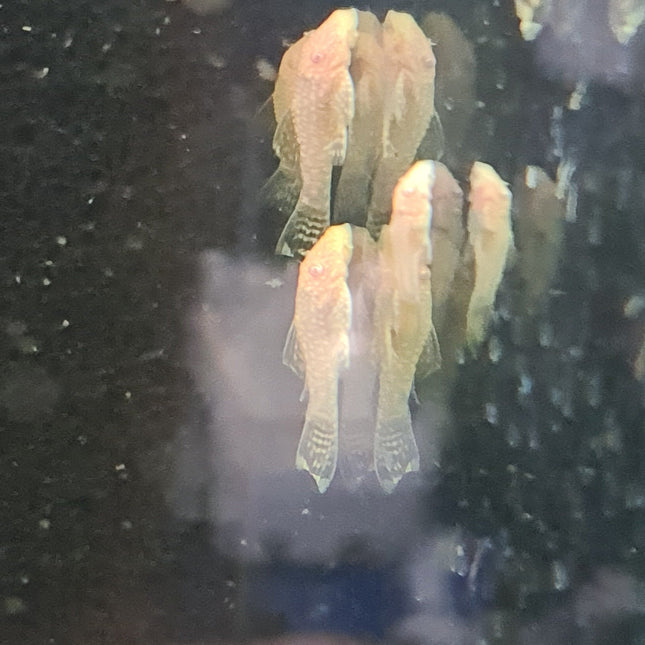
The Albino Bristlenose is a variety of the common Bristlenose catfish, a popular freshwater aquarium fish. It is named for its distinctive bristle-like protrusions on its face, which are used to help the fish navigate and sense its environment. The Albino Bristlenose has a white or pinkish body and red eyes, due to a lack of pigmentation in the skin and scales. It typically grows to be about 3-5 inches long, making it a relatively small and manageable aquarium fish. In addition to its unique appearance, the Albino Bristlenose is known for its hardiness and ease of care. It is a peaceful, herbivorous fish that does well in community tanks with other non-aggressive species. They are also effective at keeping aquariums clean, as they feed on algae and other organic matter. Overall, the Albino Bristlenose is a great choice for aquarium hobbyists looking for a visually interesting, low-maintenance fish that can also help keep their tank clean.
$15.00
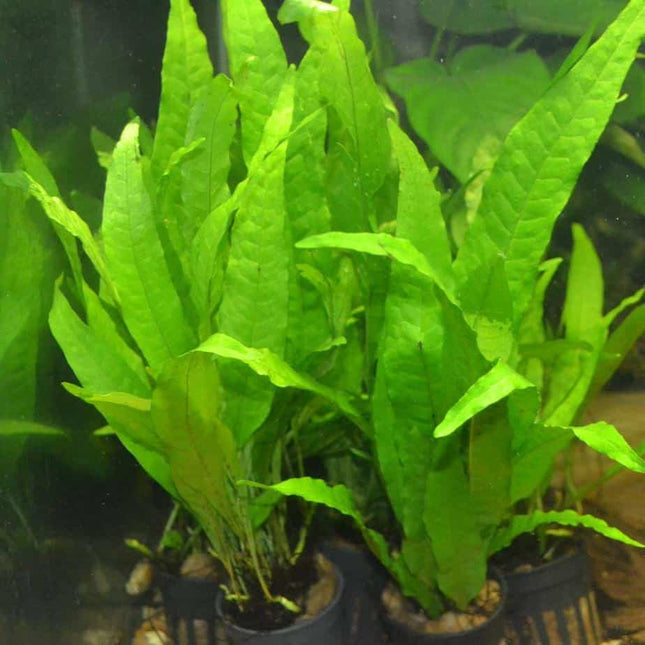
JAVA FERN: THE BEST PLANT FOR YOUR PLANTED AQUARIUM Java ferns (microsorum pteropus) are perfect for aquariums. They're small, easy to grow, and don't need a lot of light to survive. Ask us for varieties we have available. For example, there are needle leaf varieties that require bright lights, as well as more traditional 'jungle' leaves such as the Narrow Leaf, Lance Leaf, and Windelov – their many varieties to suit your needs inside your aquarium. Your fish will appreciate the natural hiding spots provided by Java Fern so they can get away from time to time and feel safe and secure when they want it. Identification If you want a true aquatic plant that can grow when submerged in water or even partially out, then the Java fern is perfect for your tank. Our diverse line of beautiful and delicate-looking Java plants are perfect for people who prefer an aesthetic look inside their home aqua garden without crazy maintenance requirements. When you require a go-to plant that looks great in almost any aquascapes, go with Java Ferns (from Nano Tanks Australia with our aquascaping expertise, of course!). The narrow-leaf Java fern generally boasts long, skinny leaves, with the plant growing to a height of 10-12 inches (25-30 cm). Java Fern is perfect for those who have limited space or are trying to create an artificial jungle feel in their aquarium. The plants need bright light, but indirect (not right under the light), so they can grow properly. Keep in mind the sun has a much more potent energy than your tiny aquarium lights, so aquarium keepers can tend to underestimate the wattage and spectrum required. Saying that, in nature Aquatic Java Fern tends to never receive direct light in the jungle river. So although the Java Fern will be fine with low light in the tank, its growth rate will not impress you. What You Should Know about Java Fern It's probably better than any other plant that would grow inside an aquatic environment for this reason - its fronds are big enough for fish to swim through them without getting stuck between leaves. A striking addition to any freshwater planted aquarium, perfect if you have cichlids or South American fish. Fortunately, it's also relatively easy for plant-eating goldfish and other tank mates to leave it alone because of its tough rhizomes! Java Fern does well in water with pH levels between 6-7.5, as long as the alkalinity stays below eight dKH (aka carbonate hardness). If you see black spots (or brown spots) in your plant's leaves, don't worry - they do that. Java ferns have veins running through them, and sometimes new bumps will pop up on the leaf from which a new shoot emerges. Planting and Replanting Java Fern in the Aquarium Java ferns grow beautifully with other live plants since they are so robust, but they also make a great centrepiece for the aquarium when planted alone. Alternatively, you can attach java fern to aquarium decorations (like rock or driftwood) to create an elegant look that will not overwhelm your fish tank with too much greenery! Java Fern is a hardy plant that can live in any tank size, making it perfect for apartment dwellers who don't have room for large aquariums! If the water stays clean (and you're not adding liquid fertiliser), this resilient Fern's growth will remain consistent without any problems. The Fern prefers water with soft-to-moderate temperatures of 22 degrees Celsius. Data at a glance for Java Fern Family: Polypodiaceae Care Level: Easy Growth Rate: Low to Moderate Maximum Size: 30cm Minimum Tank Size: 20 Litres (tall tank) Water Conditions: 20-28°C pH 6.0-7.5 KH 3-8 Lighting: Low to Moderate (Depending on the desired rate of growth) Propagation: Adventitious Plantlet/Rhizome Division Placement: Mid to Background
$15.00
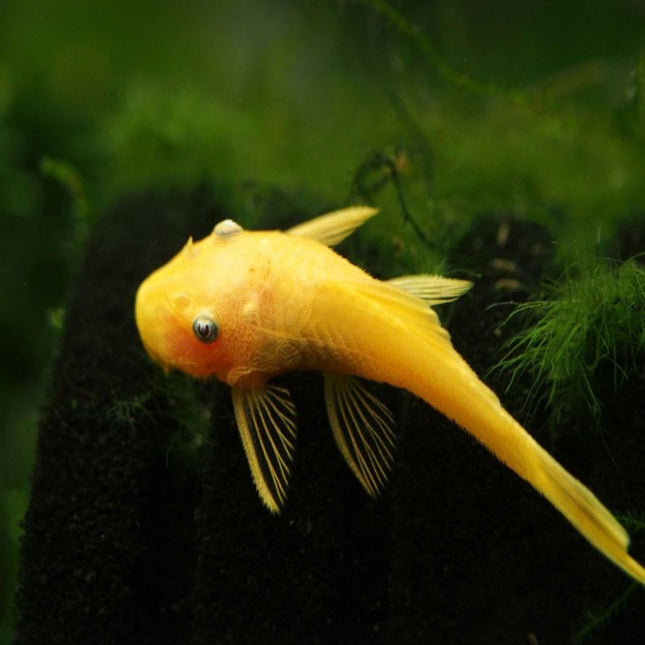
The Blue Eye Lemon Bristlenose Pleco is a member of the Loricariidae family. The fish species are often bred in aquariums and can be easily distinguished by its brown marbled pattern, which includes bristles on their facial area as it grows older. Both males and females grow these appendages with age starting from sub-adulthood until they become adults.
$15.00
You have seen 720 out of 933 products